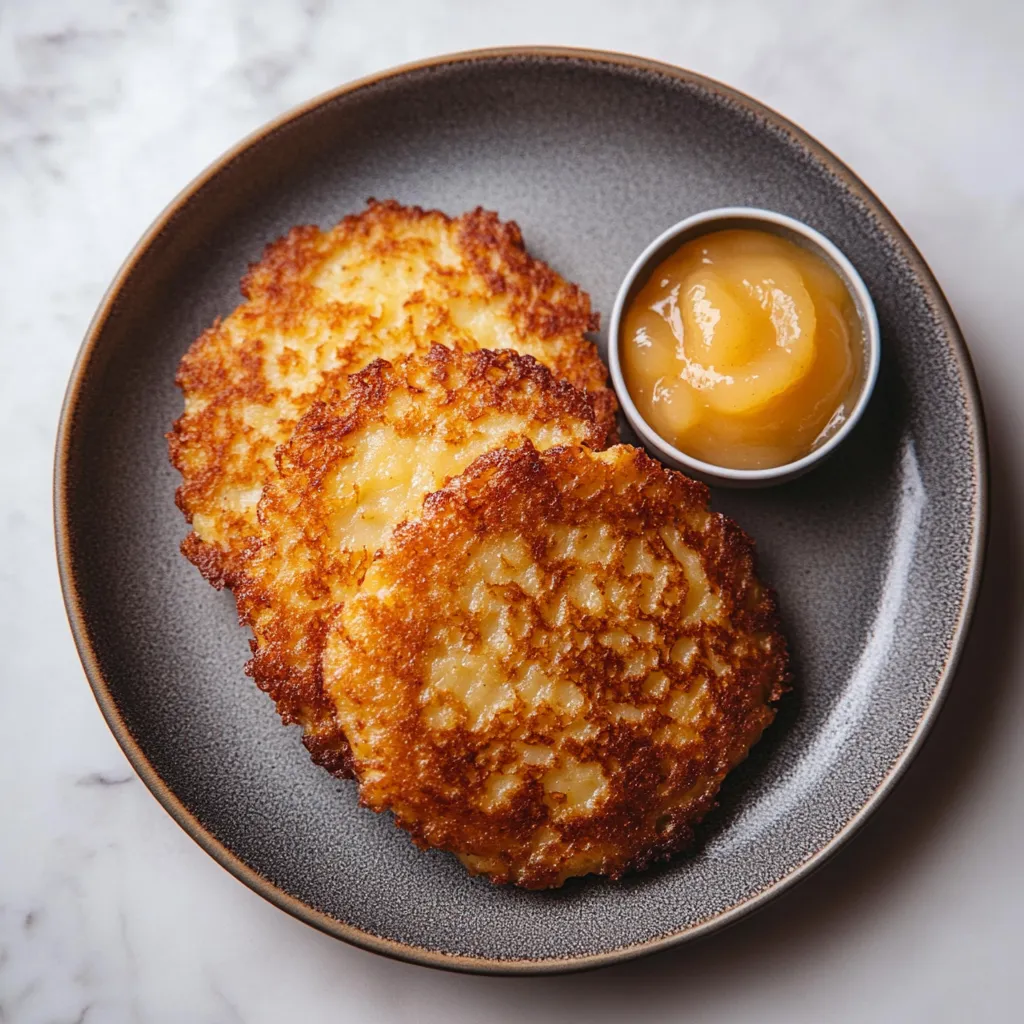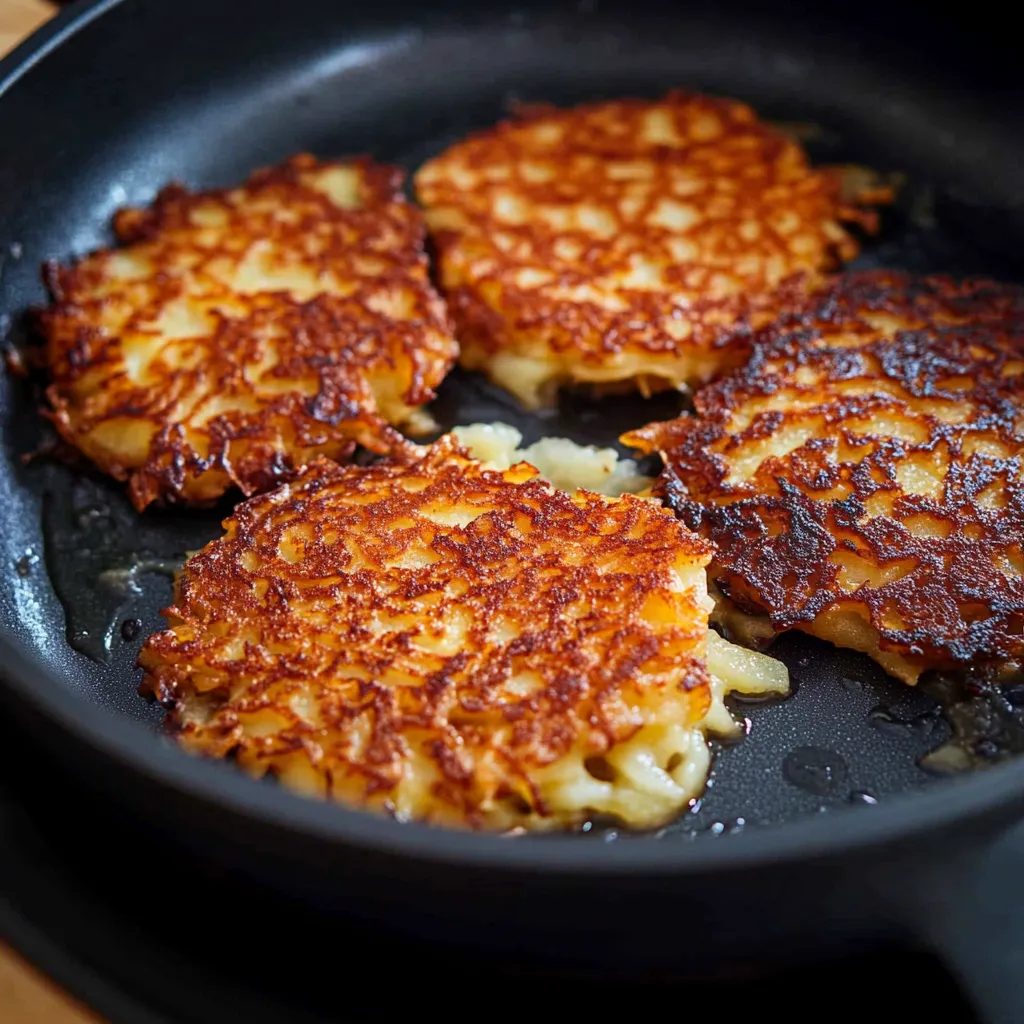 Pin it
Pin it
These authentic German potato pancakes, known as Kartoffelpuffer, deliver the perfect combination of crispy golden exteriors and tender, fluffy interiors that make them irresistible comfort food. Made from finely grated potatoes and onions bound together with eggs and a touch of nutmeg, these savory pancakes are pan-fried to perfection and traditionally served with sweet applesauce for the ultimate balance of flavors. Simple yet satisfying, they represent the heart of German home cooking at its finest.
I made these for my German neighbor last weekend, and she closed her eyes with the first bite, saying they tasted exactly like her grandmother used to make! My skeptical teenager, who typically avoids anything that looks "different," ended up eating four of them and asking when I'd make them again. The combination with applesauce was a revelation—sweet and savory perfection.
Ingredients
- Yellow potatoes (Yukon Gold): The ideal choice for their perfect balance of starch and structure. They grate easily, hold together well during cooking, and provide the creamy interior texture that makes these pancakes special.
- Onion: Essential for authentic flavor, adding sweetness and depth that transforms simple potatoes into something extraordinary. Don't skip this ingredient—it's crucial to the traditional taste.
- Eggs: Act as the binding agent that holds everything together while adding richness and helping create that perfect tender interior texture.
- Salt, pepper, and ground nutmeg: The holy trinity of seasonings for German potato pancakes. The nutmeg is particularly important, adding warmth and that distinctive flavor that makes these authentically German.
- Vegetable oil: Needed for pan-frying to achieve that gorgeous golden-brown crust. Choose an oil with a high smoke point for the best results.
- Applesauce: The traditional accompaniment that provides sweet, tart contrast to the savory pancakes. This pairing is essential to the authentic German experience.
Instructions
- Step 1:
- Prepare the potatoes and onions by peeling 2 pounds of Yukon Gold potatoes and 1 medium onion. Using the fine side of a box grater or a food processor with the finest grating disk, grate both the potatoes and onion until they're very finely shredded. The finer the grate, the better the pancakes will hold together and cook evenly. Working quickly prevents the potatoes from browning, though a little discoloration won't affect the final taste.
- Step 2:
- Extract excess moisture by placing the grated potatoes and onion in a fine-mesh strainer, nut milk bag, or clean kitchen towel. Press and squeeze firmly to remove as much liquid as possible, collecting the liquid in a large bowl beneath. This step is crucial—excess moisture will prevent the pancakes from becoming crispy and will make them fall apart during cooking. Continue squeezing until very little liquid comes out when pressed.
- Step 3:
- Separate and save the potato starch by letting the collected liquid sit for 5-10 minutes. The heavy potato starch will settle at the bottom as a thick, white layer. Carefully pour off the clear liquid from the top, leaving the valuable starch behind. This natural starch acts as an additional binding agent and helps create the perfect texture. Don't worry if the separation isn't perfect—some liquid mixed with the starch is actually beneficial.
- Step 4:
- Create the pancake mixture by placing the squeezed potatoes and onion in a large mixing bowl. Add 2 beaten eggs, 1 teaspoon salt, 1/2 teaspoon black pepper, and 1/4 teaspoon ground nutmeg. Mix thoroughly until all ingredients are evenly distributed. Add the reserved potato starch and mix again until the mixture holds together when squeezed in your hand. The consistency should be cohesive but not overly wet or dry.
- Step 5:
- Heat the oil properly by adding about 1/4 inch of vegetable oil to a large, heavy-bottomed skillet or cast-iron pan. Heat over medium-high heat until the oil shimmers and a small piece of potato mixture sizzles immediately when dropped in. The right temperature is crucial—too hot and the outside will burn before the inside cooks; too cool and the pancakes will absorb oil and become greasy.
- Step 6:
- Form and cook the pancakes by taking about 1/4 cup of the potato mixture and placing it in the hot oil. Use a spatula to gently flatten it into a pancake about 4 inches in diameter and 1/2 inch thick. Work in batches, leaving space between pancakes. Cook for 4-5 minutes on the first side until deep golden brown and crispy, then carefully flip and cook another 4-5 minutes on the second side. The pancakes should be golden brown and crispy outside while tender inside.
- Step 7:
- Drain and serve by transferring the cooked pancakes to a plate lined with paper towels to absorb excess oil. Reduce heat to medium if the pancakes are browning too quickly. Keep finished pancakes warm in a 200°F oven while cooking remaining batches. Serve immediately while hot and crispy, accompanied by applesauce or your choice of traditional toppings.
 Pin it
Pin it
I learned from my German grandmother-in-law that the secret to truly authentic Kartoffelpuffer is patience—both in properly squeezing out moisture and in not rushing the cooking process. She always said, "Good potato pancakes cannot be hurried," and she was absolutely right. The extra time spent on preparation makes all the difference in achieving that perfect crispy-yet-tender texture.
Mastering the Grating Technique
The fineness of your grate significantly impacts the final texture of your potato pancakes. Coarsely grated potatoes create pancakes that fall apart easily and don't achieve the proper cohesive texture. Using the finest holes on your box grater or the finest disk in a food processor creates the ideal consistency. If using a food processor, pulse rather than running continuously to avoid over-processing into mush. Work quickly once the potatoes are grated, as exposure to air causes oxidation and browning. While this doesn't affect taste, it can make the pancakes less visually appealing. Some cooks like to place grated potatoes in lemon water briefly to prevent browning, but this can add unwanted acidity and isn't necessary if you work efficiently. The key is achieving uniform, fine shreds that will bind together properly when cooked.
Understanding Potato Starch Recovery
The process of separating potato starch from the squeezed liquid is a traditional technique that significantly improves the pancakes' texture. When you grate potatoes, you break cell walls and release starch along with water. The heavy starch settles to the bottom while the lighter water remains on top. This recovered starch acts as a natural binding agent, much like adding flour, but without changing the flavor. If you're in a hurry, you can skip this step, but the pancakes won't hold together quite as well. The starch also helps create a crispier exterior by forming a light coating during cooking. Don't worry if you can't achieve perfect separation—even partially separated starch helps. Some moisture remaining with the starch actually helps create the proper consistency for forming the pancakes.
Temperature Control and Oil Management
Achieving the perfect crispy exterior requires careful attention to oil temperature and maintenance. Start with medium-high heat to heat the oil, then adjust as needed during cooking. The oil should be hot enough to sizzle immediately when batter hits it but not so hot that it smokes or burns the pancakes before they cook through. A good test is dropping a small piece of the mixture into the oil—it should sizzle vigorously and start browning within 30 seconds. As you cook multiple batches, the oil temperature will fluctuate, so adjust heat accordingly. Between batches, remove any burnt bits from the oil with a slotted spoon to prevent them from affecting the flavor of subsequent pancakes. If the oil becomes too dark or develops an off smell, strain it or replace it entirely. Maintaining clean, properly heated oil is essential for achieving consistently crispy, golden pancakes.
I discovered this recipe through my marriage to someone of German heritage, and it's become one of our most treasured family traditions. What initially seemed like a simple potato dish revealed itself to be something much more special—a perfect example of how traditional techniques can transform humble ingredients into something extraordinary. The process of making these pancakes is almost meditative: the careful grating, the patient squeezing, the attentive cooking. Each step builds toward that magical moment when you achieve the perfect balance of crispy exterior and fluffy interior. Served with tart applesauce, these pancakes create a harmony of flavors and textures that speaks to the wisdom of generations of German cooks who perfected this simple yet sophisticated dish. They've become our go-to comfort food, proving that the best recipes often come from honoring time-tested traditions.
Frequently Asked Questions
- → What potatoes work best for German potato pancakes?
- Use starchy potatoes like Russets or Yukon Gold. They hold together better and create the crispiest texture when fried.
- → How do I keep potato pancakes from falling apart?
- Squeeze out excess water from grated potatoes and save the starch that settles. Mix this starch back into the batter to help bind everything.
- → Can I make these pancakes ahead of time?
- These taste best fresh and hot. You can prep the potato mixture an hour ahead, but fry them right before serving for maximum crispiness.
- → What should I serve with German potato pancakes?
- Traditional toppings include applesauce and sour cream. Some people also enjoy them with sugar, jam, or even savory toppings like bacon.
- → Why are my potato pancakes soggy instead of crispy?
- Make sure your oil is hot enough before adding the batter. Also, remove as much moisture as possible from the grated potatoes before mixing.
- → How long do German potato pancakes last?
- Store leftovers in the fridge for up to 3 days. Reheat in a skillet or oven to restore some crispiness - avoid the microwave.
